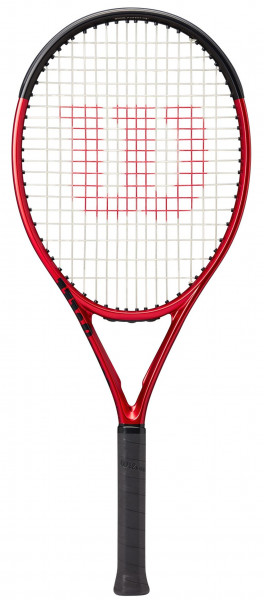Recommended retail price
The lowest price of this product from the last 30 days before the current reduction.
Wilson Clash 26 V2.0
Meet the Wilson Clash 26 V2.0, the ultimate junior tennis racquet, meticulously crafted for budding tennis enthusiasts ranging from 10-12 years of age or with a height between 141-155 cm. It's an embodiment of sophisticated technology and premium quality materials tailored to the needs of junior athletes. If your youngsters are eager to perfect their game using the best gear around, this is their match.
Designed with High-End Technologies
The Wilson Clash 26 V2.0 sports a slew of advanced features, including FORTYFIVE technology for improved rackets flexibility and stability, and PARALLEL DRILLING for a more forgiving string bed response.
This advanced racquet also integrates VERTICAL BENDING, HORIZONTAL BENDING, and TORSIONAL BENDING all aiming for a sublime blend of power, control, and comfort. It truly is a technological marvel, opening the gates of innovation and precision for junior players.
General Product Specifications
The Clash 26 V2.0 boasts a normal physical efficiency suitable for small to medium swings. It comes strung, with a string pattern of 16/19 and a recommended string tension of 23-27 kg. The racquet is made from high-quality graphite, ensuring durability and performance that will last for countless games.
| Product number: | ST82265.1 |
| Age and height: | 10-12/141-155 |
| Weight: | 245 ? more |
| Length (inches): | 26 |
| Lenght: | 66 ? more |
| Head size (cm2): | 645 ? more |
| Balance: | 315 ? more |
| String pattern: | 16/19 ? more |
| Beam profile: | 24,5/24,5/24,5 ? more |
| String tension (recommended in kg): | 23-27 ? more |
| Material: | grafit |
| Cover: | no |
| String: | yes |
| Dampener: | no |
| Technologies |
Parallel Drilling
FortyFive
Vertical Bending - Wilson
Horizontal Bending - Wilson
Torsional Bending - Wilson
|
Choosing the right racket makes playing tennis easier and more fun. This is especially important in childhood. Kids rackets are shorter, lighter, and have smaller handle sizes than senior rackets. Better-quality and more expensive children's rackets are made of graphite composites. The sizes of the handles of children's rackets are normally matched to the size of the rackets. All children's rackets have factory-made strings, which are rarely replaced due to the fact that tennis classes for younger children (4-8 years) should be conducted with balls with reduced compression and also because children do not hit the balls as hard as adults. It should be remembered that when choosing a racket for a child, apart from his age, it is also necessary to take into account physical conditions such as height and weight.
To correctly choose the size of the racket for the height and age of the child, use the following diagram:
|
Racket length |
17/19 inches |
21 inches |
23 inches |
25 inches |
26 inches |
|
Approximate height |
89 - 99 cm |
100 - 112 cm |
113 - 125 cm |
126 - 140 cm |
141 - 165 cm |
|
Approximate age |
2 - 4 years |
4 - 6 years |
6 - 8 years |
8 - 10 years |
10 - 12 years |
Junior racket handle sizes
G 2 = 4 1/4 inches = 108 mm
G 1 = 4 1/8 inches = 104 mm
G 0 = 4 inches = 100 mm
G 00 = 3 7/8 inches = 98 mm
G 000 = 3 3/4 inches = 95 mm
G 0000 = 3 5/8 inches = 92 mm
G 00000 = 3 1/2 inches = 89 mm
There are no markings in millimeters on the rockets. We converted inches to centimeters to make it easier to choose the right handle if you cannot pick up the racket in your hand.
You won’t find grip size markings in centimetres. To make it easier, we converted inches to centimetres, to help you choose the right size. It will be useful for you when you are unable to try the racket in the shop, e.g. when you want to buy a racket in the online store.
Information about the size of the grip is usually located on its bottom. Size of the grip is very important, however in contrast to the head size, not because different sizes give different effects during the game. Grip circumference must be precisely matching players hand size, only then the player may be sure that his grip will be firm, the racket will be stable in their hand, and the wrist won’t be overstrained.
The first method may be done without the racket, using only a ruler.
1. Straighten your hand and measure the distance from its centre to the end of the ring finger.
2. The result should be compared with the size chart, which we presented above which grip size should I choose.

The second method in which we may check if a certain grip is good for us will work only if we have a choice of few rackets with different grip sizes. If you don’t have one, you can always use a racket of your friend and see if his grip is good for you.
1. Grab the racket as on the picture above.
2. If the index finger of the other hand fits between the thenar eminence of the thumb and the fingertips, it means that the grip has proper size.
3. If there is too much space between the thenar eminence of the thumb and the tips of your fingers and your index finger cant fill this space, it means that the grip is too large and you should choose the grip with smaller circumference.
4. If you can’t fit your index finger it means that the grip is too small, and you should choose a racket with a bigger circumference.
















